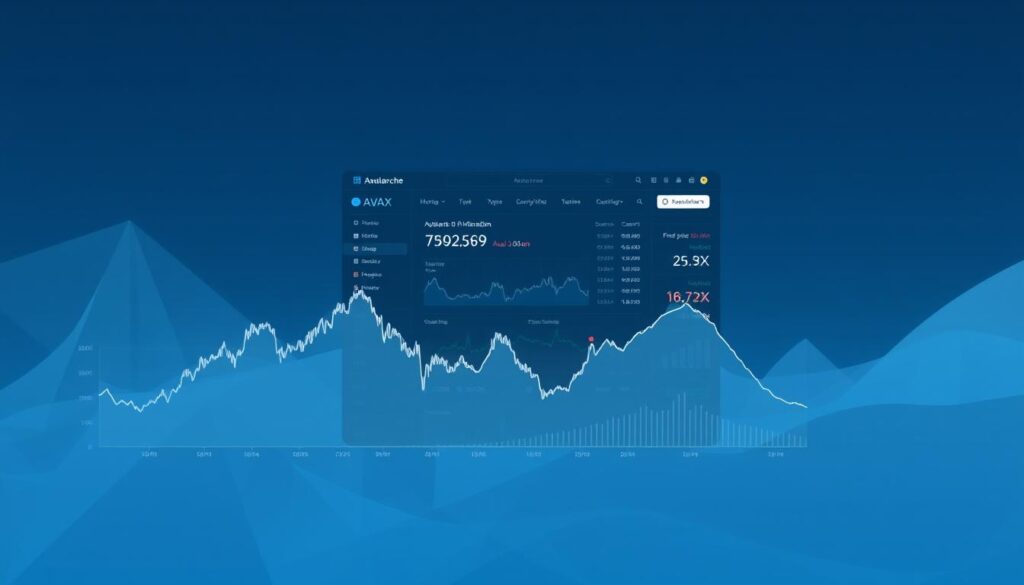Avalanche (AVAX): Unlocking the Potential of This Blockchain
Avalanche blockchain can handle up to 4,500 transactions per second. This is much faster than Ethereum’s 15-30 TPS. It shows Avalanche’s goal to solve blockchain’s speed issues without losing security and decentralization.
Launched in 2020 by Emin Gün Sirer’s Ava Labs team, Avalanche is a top smart contract platform. It’s great for decentralized finance (DeFi), NFTs, and business solutions. Its EVM compatibility makes it easy for developers to move Ethereum apps over. Plus, its Proof of Stake model uses much less energy than Bitcoin’s mining.
At its peak, over $10 billion in DeFi value was locked in Avalanche. This shows how Avalanche crypto is changing how we use blockchain technology.
Key Takeaways
- Avalanche blockchain achieves 4,500 TPS, far outpacing Ethereum’s 15-30 TPS.
- Its DeFi ecosystem once held over $10 billion in total value locked (TVL).
- AVAX uses Proof of Stake, reducing energy use by 99.95% versus Bitcoin’s mining.
- Connects to over 45 blockchains via Axelar, enabling cross-chain transactions.
- Deloitte partners with Avalanche to develop enterprise blockchain solutions.
What is Avalanche (AVAX)?
Avalanche is a blockchain platform that solves old problems of speed and scalability. It uses its own token, AVAX, for transactions, staking, and making decisions. Ava Labs created it in 2020, combining two consensus methods for quicker and cheaper operations.
Overview of Avalanche Technology
The network has a three-chain setup:
| Chain | Purpose |
|---|---|
| X-Chain | Token creation and transfers |
| C-Chain | Ethereum Virtual Machine (EVM) compatibility |
| P-Chain | Governance and validator coordination |
Key Features of Avalanche
- Near-instant finality: Transactions finalize in seconds, avoiding Ethereum’s pending status.
- 4,500+ TPS: Processes thousands of transactions per second, outperforming competitors.
- Custom virtual machines: Supports development beyond EVM, enabling diverse applications.
Benefits of Using Avalanche
Users get:
- AVAX-based transaction fees 90% cheaper than Ethereum.
- Low environmental impact via its Proof of Stake model.
Market momentum adds value: AVAX rose 9% last week, hitting $21.39. Technical indicators suggest further gains—up to $30 if resistance levels break. The RSI at 53 signals sustained buying pressure.
The Architecture of Avalanche
Avalanche blockchain is fast and scalable thanks to its unique design. At its heart, the avalanche network runs on the Avalanche Consensus Protocol. This protocol makes transactions final in under two seconds. It also removes transaction fees, making it more user-friendly and secure.
The protocol can handle 4,500 transactions per second. This is much faster than Ethereum’s 14 TPS.
Consensus Mechanism Explained
The Avalanche Consensus Protocol works in three steps: send, tally, and listen. This method skips the need for long confirmation blocks. It makes transactions almost instant.
Unlike Ethereum and Bitcoin, Avalanche doesn’t use slashing penalties. Instead, it rewards validators for honesty. If a validator is malicious, they just lose potential earnings, not their staked funds.
Network Structure and Components
Avalanche blockchain is built on three main chains:
- X-Chain: Manages asset creation and trading
- C-Chain: Ethereum Virtual Machine (EVM) compatibility for smart contracts
- P-Chain: Coordinates validator groups and subnet creation
Subnets add more flexibility, allowing for custom rules like geographic restrictions. This design lets developers create specialized blockchains. They can do this without slowing down the mainnet.
Comparison with Other Blockchains
Avalanche can handle 4,500 transactions per second, much more than Ethereum’s 14. Its EVM compatibility makes it easier for developers to deploy smart contracts. Solana focuses on speed with a single-chain design, but Avalanche balances speed with specialization.
Cardano emphasizes academic rigor, while Avalanche focuses on interoperability and speed. This makes Avalanche a strong contender in the blockchain world.
Use Cases for Avalanche
Avalanche is changing the game in many fields, from finance to gaming. Its fast transactions and low fees make it a top choice for real-world use.

DeFi Applications on Avalanche
Decentralized finance (DeFi) is booming on Avalanche. Services like Aave and Trader Joe offer lending and staking with fees 90% lower than Ethereum. In 2023, Trader Joe’s exchange saw over $10 billion in trades.
Benqi is a platform that focuses on algorithmic interest rates. It makes it easy for users to access these services.
NFTs and Gaming on Avalanche
Gamers and collectors love Avalanche for its quick transactions. Kalao and Joepegs let you create NFTs for just $0.01. Games like Crabada and Shrapnel use Avalanche for smooth asset ownership.
The upcoming game Off the Grid from Gunzilla will also use Avalanche. It ensures players keep full control over their digital assets.
Enterprise Solutions Utilizing Avalanche
Big companies are using Avalanche for their own needs. Deloitte worked with Avalanche to speed up FEMA disaster aid payments. Now, payments take minutes, not months.
Blockticity uses Avalanche to verify $275 million in cannabis products. This helps reduce counterfeit goods by 40% in tests.
Below is a table showing some key uses by big companies:
| Company | Use Case | Impact |
|---|---|---|
| Deloitte | FEMA Disaster Aid | Streamlined $1.3B in disaster funds |
| Blockticity | Supply Chain Certifications | Reduced counterfeit goods by 40% in pilot programs |
| TYB | Reward Loyalty Programs | 21M users in South Korea use Avalanche-powered digital collectibles |
Key Industry Stats
- Lemonade insures 500,000+ Kenyan farmers with $2 policies
- IntainMARKETS targets $4 trillion in structured finance assets
- 2024 saw 8.12M weekly transactions on Avalanche
Getting Started with Avalanche
With the avax price at $22.854—a 3.83% increase—now is a great time to dive into Avalanche. This guide will help you buy, store, and manage AVAX tokens easily.
How to Buy AVAX
First, pick a reliable avax exchange. Sites like Binance, Coinbase, and Kraken make buying AVAX simple. Here’s how to start:
- Create an account and verify your identity
- Add funds using a debit card, bank transfer, or crypto
- Look for AVAX and make a trade
For a decentralized way, try Trader Joe on Avalanche’s network. It offers direct trading without middlemen. Gemini also added AVAX/GUSD perpetuals in March 2024, opening up more trading paths.
Choosing a Wallet for AVAX
For safe storage, choose wallets that work with Avalanche. Here are some:
- MetaMask: A browser extension for DeFi apps
- Ledger: A hardware wallet for safe storage
- Core Wallet: The official Avalanche wallet with staking options
Make sure to use two-factor authentication and never share your private keys.
Understanding AVAX Transaction Fees
Avalanche’s fees are quite competitive. They change based on network activity but are often lower than Ethereum’s. Transactions are confirmed in 2 seconds, and fees are burned, which helps control inflation. To save money:
- Transfer during off-peak hours
- Choose Subnets with lower fees
- Keep an eye on network congestion with block explorers
Staking AVAX in approved wallets also earns you rewards and helps secure the network.
Development on Avalanche
Developers on the avalanche crypto platform have top-notch tools and a growing ecosystem. The avalanche network has a modular setup for innovation and growth.
Tools and Resources for Developers
Developers have tools to make apps, test, and deploy them easily. Key resources include:
- Avalanche-CLI: Command-line interface for node management
- AvalancheJS: JavaScript library for API integration
- Avalanche Network Runner (ANR): Simplifies node setup
- Remix IDE integration: Solidity development environment
Over $290M is given through the Multiverse program. This helps developers fund subnet and dApp projects.
Smart Contract Capabilities
Avalanche’s C-Chain uses the Ethereum Virtual Machine (EVM). This lets developers easily move Ethereum smart contracts. Key features include:
| Feature | Avalanche | Ethereum |
|---|---|---|
| TPS | 4,500+ | 15 |
| Transaction Cost | Low, fixed fees | Gas fees fluctuate |
| Finality | Seconds | Minutes |
Subnets let developers create custom blockchains. They can tailor security and rules for enterprise needs.
Community Support and Contributions
“Avalanche’s developer tools cut deployment time by 60%.”
The community grows through:
- Annual summits (e.g., Barcelona’s 2023 Avalanche Summit II)
- Bug bounties and hackathons like Istanbul’s 2021 event
- Grants programs from the Avalanche Foundation
Over 1,000 validators secure the network. They earn rewards through proof-of-stake. The Avalanche Academy and Discord forums offer ongoing support and education.
The Future of Avalanche
AVAX price movements and ecosystem growth are key topics in avax news. Avalanche’s deflationary model, with 360 million tokens for staking rewards, could boost its value. It has recently become the 14th largest cryptocurrency, with a market cap of $6.33 billion.

Upcoming projects include better subnet capabilities and cross-chain solutions. Developers are adding enterprise-grade tools to attract big investors. Here are some 2025-2030 price forecasts:
| Year | Bearish | Average | Bullish | ROI |
|---|---|---|---|---|
| 2025 | $18.50 | $19.80 | $22.06 | 12.89% |
| 2030 | $37.93 | $45.70 | $55.05 | 214.32% |
- AVAX price volatility at 8.55% reflects market uncertainty.
- Strong correlations with Render Token (+97.9%) and NEAR Protocol (+95.9%) suggest ecosystem synergy.
- Resistance levels (R1: $20.287) and support (S1: $19.112) indicate short-term trading ranges.
Analysts predict 2030 prices between $6.05 and $61.24, driven by DeFi adoption and enterprise integrations. Investors should watch for institutional interest and regulatory changes. These could affect avax price trends. While some predict $55.05 by 2030, there are still risks in the crypto market.
Avalanche Ecosystem and Partnerships
The avalanche ecosystem is growing fast. It’s doing this through smart partnerships and tech integrations. Big names like Deloitte and AWS are teaming up with Avalanche. This shows how it’s helping blockchain grow in the real world.
Collaborations with Major Brands
Big brands are using Avalanche for new ideas. Deloitte is working on disaster recovery systems. Tixbase and Passolig are using it for Turkey’s ticketing needs.
Financial groups are also checking it out for payment systems. This shows they trust the avalanche token.
- Deloitte: Disaster recovery funding solutions
- Amazon Web Services (AWS): Cloud infrastructure collaboration
- Tixbase/Passolig: Ticketing systems in Turkey
Integration with Other Technologies
Avalanche connects to Ethereum through special bridges. This makes moving assets easy. It also works with Chainlink for real-world data and Ethereum apps.
This makes the avalanche ecosystem bigger and better.
| Feature | Avalanche | Ethereum/Solana |
|---|---|---|
| TPS | Thousands | Ethereum: ~15-45 | Solana: ~50k (but with outages) |
| Finality | Sub-second | Ethereum: 12-15 mins | Solana: 1-2 seconds |
| Consensus | Combines classical and Nakamoto | Ethereum: Proof-of-stake | Solana: Proof-of-history |
The Role of Validators in the Ecosystem
Validators keep the network safe by staking AVAX tokens. They earn rewards for checking transactions. This way, everyone gets a say and gets rewarded.
Thanks to these efforts, Avalanche is becoming a top choice for blockchain.
Challenges Facing Avalanche
Avalanche crypto is growing fast, but it faces big challenges. Recent news shows a 10% increase in development. Yet, transaction volume is growing slowly. Here are the main risks for Avalanche’s future.
Scalability Concerns
Avalanche can handle 6,500 transactions per second. But, Ethereum 2.0 and Solana are catching up. Its subnet architecture tries to manage the load, but daily transactions have dropped.
This fall makes people wonder if Avalanche can handle high demand. It’s a big question for its future.
| Platform | TPS | Block Time |
|---|---|---|
| Avalanche | 6,500 | |
| Ethereum 2.0 | 100,000 (projected) | 12 seconds |
| Solana | 50,000 | 0.4 seconds |
Security Risks and Solutions
- Smart contract exploits are still a problem, even with more developers.
- Bug bounty programs and audits help fix EVM-compatible apps’ issues.
- TVL fell from $1.65B to $1.28B, showing market doubts.
Regulatory Issues
Regulatory uncertainty is a big worry. Partnerships with Amazon Web Services and Tencent Cloud help with compliance. But, new address creation has plummeted.
AVAX’s 48% circulating supply is low among top cryptos. This raises liquidity concerns. Recent news highlights efforts to work with regulators worldwide.
Conclusion: The Promise of Avalanche
Avalanche has grown a lot since its start in 2020. It went from $0.5 to over $146 in 2021. This shows it could be a top blockchain platform. Its fast and scalable design makes it great for apps that need to work well together.
Investors and developers find it useful for many things. This includes DeFi and big business solutions. It’s a flexible place for innovation.
Why Invest in Avalanche?
AVAX has big plans for the future. It’s working on subnets and making it easier for different systems to talk to each other. This could make it even more popular.
At $1000 per token, its huge market cap of $396 billion could make it a leader. The price has gone up a lot recently, showing people are optimistic. Experts think it could hit $800 to $2000 by 2025 because of its advanced tech.
The Role of Community in AVAX Growth
The community is key to Avalanche’s growth. Developers are making apps that work well because of its speed. People who hold AVAX get rewards for staking it.
Working with big brands and adding new tech helps more people use it. The community helps decide how the network should change. This keeps it safe and new.
Final Thoughts on the Future of Avalanche
Avalanche has a small inflation rate and a limited number of tokens. This helps keep its value high over time. But, it faces challenges like laws that might change.
Its design and focus on big business make it ready for Web3. As more people use the AVAX exchange, it could grow a lot. It has shown big swings in price before, but it could keep going up.




